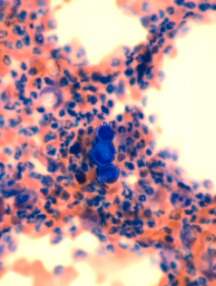
Wright's stain, 500x

Wright's stain, 500x
Blastomycosis
Blastomycosis is a systemic infection caused by Blastomyces dermatitidis, a dimorphic fungus. The organism exists as yeast in tissues at body temperature. These organisms have a thick, refractile, double capsule. The cells are dark blue when stained with Wright’s stain and show broad-base budding. People and dogs are the most frequently infected, however, the infection can also be found in other species such as cats, horses, ferrets and some wild animals.
Spores enter the patient via the respiratory tract and a primary infection establishes itself in the lungs. Solitary cutaneous lesions are also possible with this organism, however it is more common for cutaneous lesions to be linked to a systemic infection. It is possible to miss the organism in the cytology, such that results from other complementary tests may be required for a diagnosis, such as serology and culture. Three yeasts of Blastomyces sp. can be seen in the microphotograph below on the left in a background of neutrophils and erythrocytes; the outline of these organisms have been "cut out" and pasted to the right of the microphotograph to eliminate background for a better appreciation of detail of the microorganism.
 Wright's stain, 500x
|
Wright's stain, 500x |